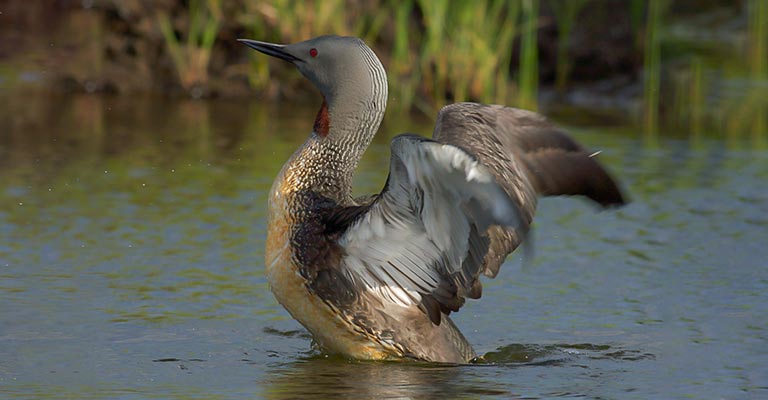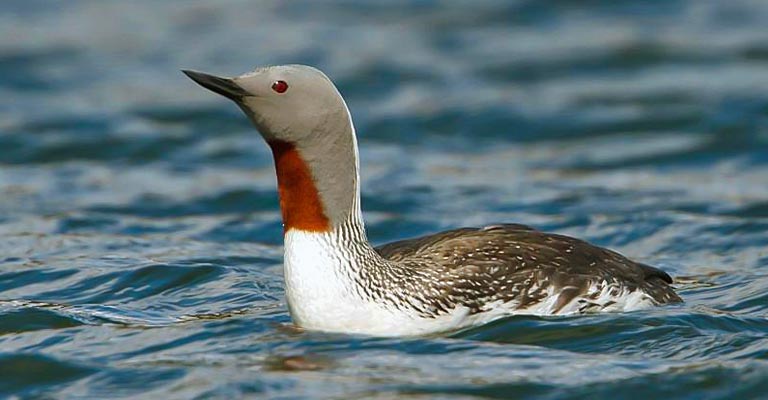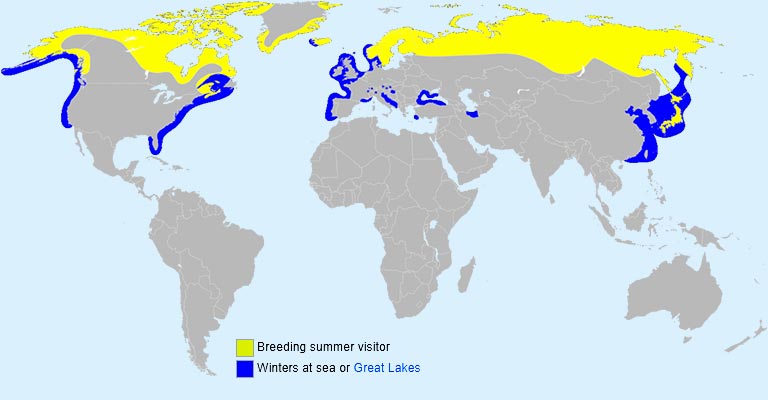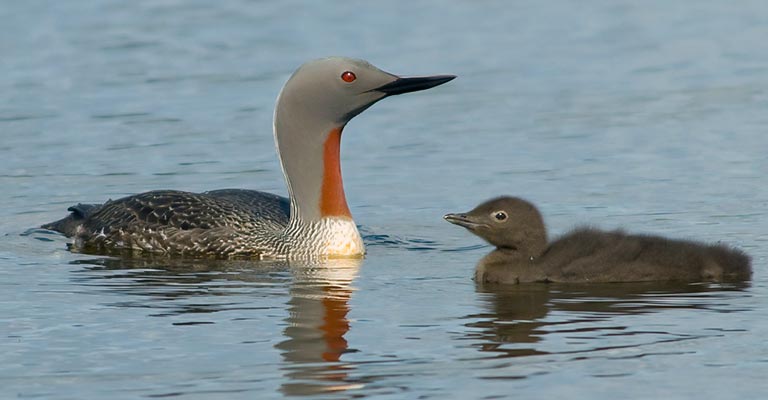The Red-throated Loon, scientifically known as Gavia stellata, is a captivating bird species renowned for its striking appearance and unique behaviors.
With its distinctive red throat patch, slender body, and haunting vocalizations, the Red-throated Loon captures the imagination of birdwatchers and enthusiasts worldwide.
Found in North America, Europe, and Asia, this species exhibits fascinating nesting habits, diving expertise, and territorial displays during the breeding season.
Its adaptability to diverse aquatic habitats and resilience to environmental challenges make it a subject of interest for researchers and conservationists. So, stay sharp.
Pick Out Criteria of Red-throated Loon

The Red-throated Loon (Gavia stellata) is a distinctive bird species belonging to the family Gaviidae.
Known for its striking appearance and unique vocalizations, the Red-throated Loon is primarily found in North America, Europe, and Asia. Identifying this specific bird requires attention to several key characteristics:
Size and Shape
Red-throated Loons are medium-sized birds, measuring about 58-74 cm in length with a wingspan of approximately 105-130 cm. They possess a slender, streamlined body shape with a long neck and pointed bill.
Plumage
During the breeding season, adult Red-throated Loons exhibit a striking plumage pattern characterized by a distinctive red throat patch contrasting with a silvery-gray neck and head.
Their back and wings are sprinkled with black and white, while the underparts are white. The red throat patch fades outside the breeding season, and the plumage becomes less distinct.
Bill Color and Shape
The bill of the Red-throated Loon is a defining feature, characterized by its straight, slender shape with a slight upturn at the tip.
Typically dark in color, ranging from grayish-black to black, this bill is well-suited for capturing prey underwater, reflecting the bird’s adept diving abilities and specialized feeding strategies.
Eye Color
The eyes of Red-throated Loons are typically dark brown. The dark brown eyes of the Red-throated Loon complement its striking appearance, adding to its captivating gaze.
This characteristic, common among species members, serves both functional and aesthetic purposes, aiding in visual perception and communication while contributing to the bird’s overall allure.
Behavior
These birds often swim low in the water, partially submerging their bodies. They are adept divers and frequently disappear beneath the surface in search of prey, resurfacing at a distance from their original location.
Vocalizations
Red-throated Loons are known for their haunting, eerie calls, which include wails, yodels, and tremolos. Their vocalizations are often heard during the breeding season and are used for territory defense and communication.
Habitat
Red-throated Loons prefer to inhabit freshwater lakes, ponds, rivers, and coastal marine environments during the breeding season.
Outside of breeding, they can also be found in estuaries, bays, and coastal waters during migration and wintering periods.
Flight Pattern
Red-throated Loons display swift, direct flight with rapid wingbeats when in flight. They fly low over the water’s surface, occasionally gliding for short distances.
Identifying the Red-throated lion involves considering its size, plumage, bill shape, eye color, behavior, vocalizations, habitat preferences, and flight pattern.
By paying attention to these critical characteristics, birdwatchers and enthusiasts can confidently recognize and appreciate this unique species in its natural environment.
Taxonomy of Red-throated Loon

Check out the table below detailing the taxonomy details of the Red-throated Loon:
| Taxonomic Rank | Classification |
| Domain | Eukaryota |
| Kingdom | Animalia |
| Phylum | Chordata |
| Class | Aves |
| Order | Gaviiformes |
| Family | Gaviidae |
| Genus | Gavia |
| Species | G. stellata |
The Red-throated Loon (Gavia stellata) belongs to the animal kingdom (Animalia), the class of birds (Aves), and the order of Gaviiformes, which comprises only loons.
Within this order, it falls under the family Gaviidae, commonly known as the loon family. The genus Gavia encompasses all loon species, with the Red-throated Loon classified explicitly under the species stellata.
Taxonomically, it is closely related to other loon species but is distinguished by its unique physical characteristics, vocalizations, and habitat preferences.
This systematic classification helps scientists understand the Red-throated Loon’s evolutionary relationships and ecological roles within the broader avian community.
Red-throated Loon Life History
The Red-throated Loon (Gavia stellata) is a captivating bird species renowned for its elegance and resilience. Understanding its life history provides insights into its remarkable adaptations and the challenges it faces in its environment.
Food
Red-throated Loons are proficient divers, primarily feeding on a diet of fish, crustaceans, and aquatic invertebrates.
Their slender, pointed bills enable them to efficiently capture prey underwater, often diving to considerable depths in pursuit of food.
During the breeding season, they may also consume small amphibians and insects to supplement their diet and nourish their growing chicks.
Habitat
These birds exhibit a diverse range of habitat preferences throughout their annual cycle.
During breeding, they favor nesting sites near freshwater lakes, ponds, and marshes in northern North America, Europe, and Asia.
In winter, they migrate to coastal marine environments, estuaries, and bays, where they find ample food resources and milder climates conducive to survival.
Range Map

The range of the Red-throated Loon extends across vast regions of the Northern Hemisphere, encompassing breeding grounds in the Arctic tundra and wintering areas along coastal regions and offshore waters.
A range map visually depicts the distribution of this species, highlighting the areas where it can be found during different seasons of the year.
Breeding
Breeding among Red-throated Loons typically occurs in remote, undisturbed northern tundra areas.
They construct shallow nests on the ground near water bodies, using vegetation and other natural materials to provide camouflage and protect their eggs.
Breeding pairs engage in elaborate courtship displays, vocalizations, and territorial behavior to establish and defend their nesting territories.
Diseases
Like many bird species, red-throated loons are susceptible to various diseases and health conditions. Avian botulism, parasites, and environmental contaminants are potential threats to their well-being.
In some regions, habitat degradation and pollution pose significant challenges to their survival, leading to declines in population numbers and reproductive success.
Treatment
Efforts to address diseases and health issues in Red-throated Loons often involve a combination of veterinary care, rehabilitation, and conservation measures.
Wildlife rehabilitation centers may provide medical treatment and supportive care to injured or sick individuals while conservation organizations work to address underlying factors contributing to disease outbreaks and habitat degradation.
Conservation
Conservation initiatives to protect the Red-throated Loon focus on preserving critical breeding habitats, mitigating threats from human activities, and monitoring population trends.
International collaborations and agreements strive to conserve migratory routes and wintering areas essential for the species’ survival.
Additionally, research efforts to understand the ecology and behavior of Red-throated Loons inform conservation strategies and management decisions.
The life history of the Red-throated Loon is characterized by its remarkable adaptations to diverse habitats, challenges associated with breeding, threats from diseases and environmental factors, and ongoing conservation efforts to ensure its long-term survival.
By understanding and addressing the complex interplay of biological, ecological, and human-related factors affecting this species, we can work towards a future where Red-throated Loons thrive in their natural environments.
Nesting Habit of Red-throated Loon
Check out the following table detailing the nesting habits of the Red-throated Loon:
| Nesting Details | Facts |
| Clutch Size | 1-3 eggs |
| Number of Broods | Typically 1 per breeding season |
| Egg Length | Approximately 7.6 – 9.5 cm (3 – 3.7 inches) |
| Egg Width | Approximately 4.5 – 5.5 cm (1.8 – 2.2 inches) |
| Incubation Period | Around 24-29 days |
| Nestling Period | 55-65 days |
| Egg Description | Elliptical, smooth, and slightly glossy; variable in coloration, ranging from olive-green to brown, with dark blotches or speckles |
These nesting details provide insights into the reproductive behavior and biology of the Red-throated Loon, highlighting the species’ adaptations for successfully raising offspring in its natural habitat.
Red-throated Loons construct shallow nests near freshwater lakes or ponds, typically in remote, undisturbed northern tundra areas.
The nests are made of grass, moss, and other vegetation, providing camouflage and egg protection. Breeding pairs use elaborate courtship displays to establish and defend their nesting territories.
The female typically lays 1-3 elliptical, speckled eggs, which both parents take turns incubating for about 24-29 days.
After hatching, the chicks remain in the nest for approximately 55-65 days, caring for and fed by both parents until they are ready to fledge.
10 Behavioral Habits of Red-throated Loon

The Red-throated Loon exhibits a fascinating array of behavioral habits that reflect its adaptation to its environment and life history.
Understanding these behaviors provides valuable insights into the ecology and biology of this remarkable bird species.
- Diving Expertise: Red-throated Loons are proficient divers, capable of plunging underwater to depths of up to 60 meters in search of prey. Their streamlined bodies and powerful legs enable them to navigate underwater swiftly and efficiently.
- Territorial Displays: During the breeding season, Red-throated Loons engage in elaborate territorial displays, including vocalizations, head bobbing, and ritualized movements. These displays help establish and defend nesting territories against intruders.
- Courtship Rituals: Breeding pairs participate in intricate courtship rituals involving synchronized swimming, mutual preening, and vocal duets. These displays strengthen pair bonds and reinforce the breeding partnership.
- Parental Care: Both parents share responsibility for incubating the eggs and caring for the young. They take turns brooding the nest, feeding the chicks, and protecting them from predators.
- Vocalizations: Red-throated Loons are known for haunting vocalizations, including wails, yodels, and tremolos. These calls serve multiple purposes, including territory defense, communication between mates, and signaling distress.
- Aggressive Defense: When threatened, Red-throated Loons can display aggressive behavior, including dive-bombing intruders and engaging in physical confrontations. They fiercely defend their nesting territories and offspring from potential predators and competitors.
- Feeding Strategies: While foraging, Red-throated Loons employ various feeding strategies, including stalking, pursuit diving, and surface skimming. They opportunistically feed on fish, crustaceans, and other aquatic prey found in their habitat.
- Social Behavior: Outside the breeding season, Red-throated Loons may gather in loose flocks, particularly during migration and wintering periods. These social gatherings provide opportunities for foraging and communal defense against predators.
- Nomadic Movements: Red-throated Loons exhibit nomadic movements, often traveling long distances in search of suitable breeding and feeding grounds. Seasonal changes influence their migration patterns in food availability and environmental conditions.
- Adaptation to Climate: Red-throated Loons are well-adapted to life in cold, northern environments, where they endure harsh weather conditions and seasonal fluctuations in temperature. Their thick plumage and efficient thermoregulatory mechanisms help them survive in these challenging habitats.
The behavioral habits of the Red-throated Loon reflect its evolutionary adaptations to life in aquatic environments and its strategies for survival and reproduction.
By studying these behaviors, researchers gain valuable insights into this iconic bird species’ ecological role and conservation needs.
Wrapping Up
The behavioral habits of the Red-throated Loon exemplify its remarkable adaptability and resilience in diverse aquatic environments.
From expert diving and territorial displays to intricate courtship rituals and parental care, these behaviors provide insights into this iconic bird species’ complex ecology and biology.
By understanding and appreciating the behavioral nuances of the Red-throated Loon, we can enhance conservation efforts and ensure the long-term survival of this fascinating avian species. Thank you very much.